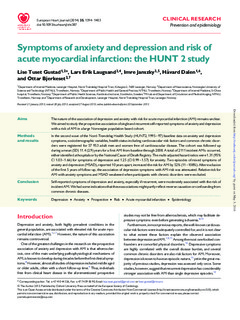| dc.contributor.author | Gustad, Lise Tuset | |
| dc.contributor.author | Laugsand, Lars Erik | |
| dc.contributor.author | Janszky, Imre | |
| dc.contributor.author | Dalen, Håvard | |
| dc.contributor.author | Bjerkeset, Ottar | |
| dc.date.accessioned | 2016-05-03T13:15:18Z | |
| dc.date.accessioned | 2016-05-04T12:54:45Z | |
| dc.date.available | 2016-05-03T13:15:18Z | |
| dc.date.available | 2016-05-04T12:54:45Z | |
| dc.date.issued | 2014 | |
| dc.identifier.citation | European Heart Journal 2014, 35(21):1394-1403 | nb_NO |
| dc.identifier.issn | 0195-668X | |
| dc.identifier.uri | http://hdl.handle.net/11250/2388628 | |
| dc.description.abstract | Aims The nature of the association of depression and anxiety with risk for acute myocardial infarction (AMI) remains unclear. We aimed to study the prospective association of single and recurrent self-reported symptoms of anxiety and depression with a risk of AMI in a large Norwegian population based cohort.
Methods and results In the second wave of the Nord-Trøndelag Health Study (HUNT2, 1995–97) baseline data on anxiety and depression symptoms, sociodemographic variables, health status including cardiovascular risk factors and common chronic disorders were registered for 57 953 adult men and women free of cardiovascular disease. The cohort was followed up during a mean (SD) 11.4 (2.9) years for a first AMI from baseline through 2008. A total of 2111 incident AMIs occurred, either identified at hospitals or by the National Cause of Death Registry. The multi-adjusted hazard ratios were 1.31 (95% CI 1.03–1.66) for symptoms of depression and 1.25 (CI 0.99–1.57) for anxiety. Two episodes of mixed symptoms of anxiety and depression (MSAD), reported 10 years apart, increased the risk for AMI by 52% (11–108%). After exclusion of the first 5 years of follow-up, the association of depression symptoms with AMI risk was attenuated. Relative risk for AMI with anxiety symptoms and MSAD weakened when participants with chronic disorders were excluded.
Conclusion Self-reported symptoms of depression and anxiety, especially if recurrent, were moderately associated with the risk of incident AMI. We had some indications that these associations might partly reflect reverse causation or confounding from common chronic diseases. | nb_NO |
| dc.language.iso | eng | nb_NO |
| dc.publisher | Oxford University Press | nb_NO |
| dc.relation.uri | http://eurheartj.oxfordjournals.org/content/early/2013/09/19/eurheartj.eht387.full.pdf?keytype=ref&ijkey=TIDUdzHpfwzqZeh | |
| dc.subject | Depression, Anxiety, Prospective, Risk, Acute, myocardial, infarction, Epidemiology | nb_NO |
| dc.title | Symptoms of anxiety and depression and risk of acute myocardial infarction: the HUNT 2 study | nb_NO |
| dc.type | Journal article | nb_NO |
| dc.type | Peer reviewed | nb_NO |
| dc.date.updated | 2016-05-03T13:15:18Z | |
| dc.source.pagenumber | 1394-1403 | nb_NO |
| dc.source.volume | 35 | nb_NO |
| dc.source.journal | European Heart Journal | nb_NO |
| dc.source.issue | 21 | nb_NO |
| dc.identifier.doi | 10.1093/eurheartj/eht387 | |
| dc.identifier.cristin | 1051188 | |
| dc.description.localcode | & The Author 2013. Published by Oxford University Press on behalf of the European Society of Cardiology. This is an Open Access article distributed under the terms of the Creative Commons Attribution Non-Commercial License (http://creativecommons.org/licenses/by-nc/3.0/), which permits non-commercial re-use, distribution, and reproduction in any medium, provided the original work is properly cited. For commercial re-use, please contact journals.permissions@oup.com | nb_NO |
